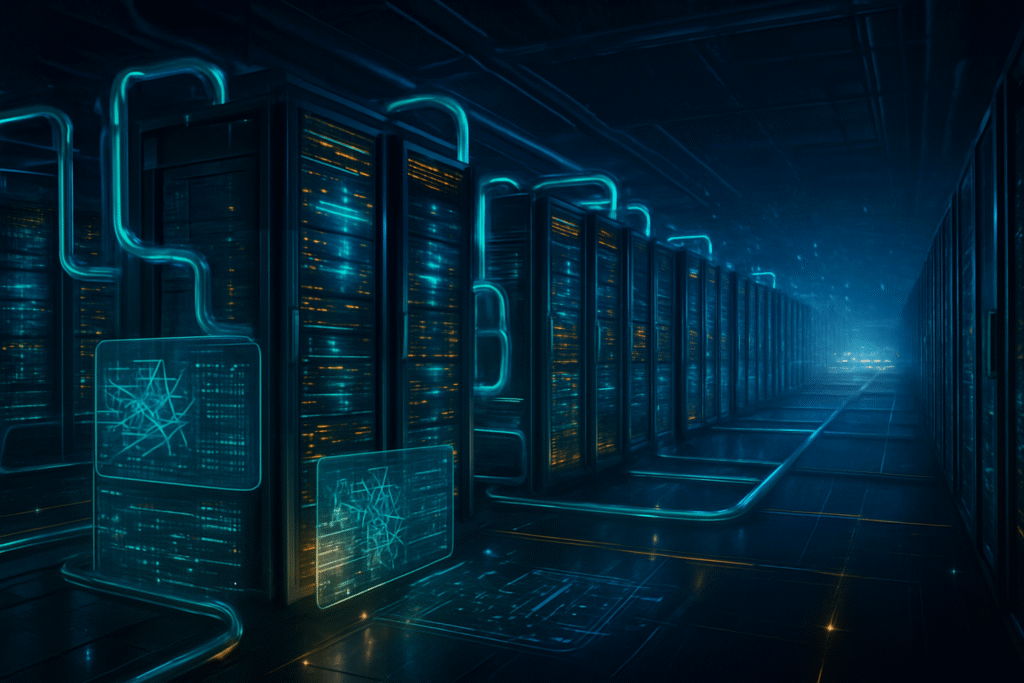
The artificial intelligence landscape is in the midst of a transformative period, marked by an unprecedented surge in demand for specialized AI servers. This "AI server boom," accelerating rapidly through October 2025, is not merely an incremental shift but a fundamental re-architecture of global computing infrastructure. Driven by the insatiable appetites of generative AI and large language models, this technological imperative is dictating massive capital expenditures from tech giants, fueling innovation in hardware design, and significantly impacting market valuations, with companies like Supermicro experiencing dramatic shifts in their fortunes. The immediate significance is a profound reshaping of both the technology sector and financial markets, as the foundational elements of the AI revolution are laid down at an astonishing pace.
The Engine Room of AI: Unpacking Next-Generation Server Technology
At the heart of this boom lies a relentless pursuit of computational power, far exceeding the capabilities of traditional servers. Graphics Processing Units (GPUs) remain the undisputed champions for AI acceleration, commanding a dominant market share. Leading the charge, companies like NVIDIA (NASDAQ: NVDA) are continually pushing boundaries, with their Blackwell platform chips expected to be mainstream offerings for high-end GPUs by 2025. These chips, alongside Application-Specific Integrated Circuits (ASICs) developed in-house by hyperscale cloud providers (CSPs) such as Google (NASDAQ: GOOGL), Amazon Web Services (NASDAQ: AMZN), and Meta (NASDAQ: META), are designed for parallel processing, essential for the intricate calculations of deep learning. Field-Programmable Gate Arrays (FPGAs) also contribute, offering a balance of flexibility and performance for specific AI workloads.
What sets these new AI servers apart is not just the processors, but the entire system architecture. Modern AI servers consume two to three times more power than their traditional counterparts, with high-performance AI racks often exceeding 50 kW. This intense power density necessitates a radical departure from conventional air-cooling. Consequently, there's a significant industry-wide shift towards advanced cooling solutions, including liquid-cooled and hybrid systems, which are becoming indispensable for managing the extreme heat generated by these powerful components. Companies like Supermicro (NASDAQ: SMCI) have emerged as leaders in direct-liquid-cooled (DLC) server technology, offering solutions that can reduce data center power usage by up to 40%.
The technical advancements extend to interconnectivity and memory bandwidth, crucial for efficiently moving vast datasets between processors. High-speed interconnects and innovations in memory packaging, such as CoWoS (Chip-on-Wafer-on-Substrate), are critical enablers. The initial reactions from the AI research community and industry experts highlight both excitement and apprehension. While the raw power unlocks new frontiers in AI model complexity and application, concerns about energy consumption and the environmental footprint of these data centers are growing. The sheer scale of investment and rapid development signifies a new era where hardware innovation is as critical as algorithmic breakthroughs.
Competitive Battlegrounds and Market Realignments
The AI server boom is creating clear winners and losers, reshaping the competitive landscape across the tech sector. Hyperscale cloud providers, including Amazon Web Services (AWS), Google, Meta, and Microsoft (NASDAQ: MSFT), are the primary beneficiaries and drivers of demand, pouring hundreds of billions into expanding and upgrading their data centers. Google alone is projected to reach $75 billion in capital expenditure in 2025, predominantly for servers and data centers. These investments fuel the growth of server manufacturers and component suppliers.
Companies like Dell Technologies (NYSE: DELL) and Hewlett-Packard Enterprise (NYSE: HPE) are frontrunners in the AI server market, securing significant orders. However, agile and specialized players like Supermicro (NASDAQ: SMCI) are also making substantial inroads. Supermicro's strategy of being first-to-market with servers integrating the latest chips from NVIDIA, AMD (NASDAQ: AMD), and Intel (NASDAQ: INTC), coupled with its expertise in liquid cooling and customizable "Building Blocks" architecture, has given it a distinct competitive edge. Over 70% of Supermicro's fiscal year 2025 Q4 revenue originated from AI platform systems, underscoring its successful pivot.
Supermicro's stock performance has been a testament to this strategic positioning. As of October 2025, SMCI stock has climbed approximately 80% year-to-date. In fiscal year 2025, the company reported a remarkable 47% year-over-year revenue increase to $22 billion, driven by strong global demand for AI data center systems. Despite a recent, temporary trim in its Q1 FY2026 revenue forecast due to delayed AI server deliveries by some customers, which caused a brief 7% dip in shares, the company maintained its full-year fiscal 2026 revenue forecast of at least $33 billion, surpassing Wall Street's estimates. This resilience, alongside over $12 billion in new orders for Q2 delivery, highlights robust underlying demand. However, the market also reflects concerns about increasing competition from larger players and potential margin compression, leading to a mixed "Hold" consensus from analysts in October 2025.
Broader Implications and Societal Undercurrents
This AI server boom is more than just a hardware trend; it's a foundational shift that underpins the broader AI landscape and societal trends. It signifies that AI, particularly generative AI, has moved from a niche research area to a core enterprise strategy across virtually every sector. The sheer scale of computational power now available is enabling breakthroughs in areas like drug discovery, climate modeling, and personalized education, driving deeper reliance on data-driven decision-making and automation.
However, this rapid expansion comes with significant concerns, particularly regarding environmental impact. The massive energy consumption of AI data centers is a critical issue. Global power demand from data centers is forecast to rise 165% by 2030 from 2023 levels, potentially surpassing the annual consumption of entire countries. This necessitates urgent attention from environmental regulators and policymakers, likely leading to mandates for energy efficiency and incentives for sustainable data center practices. Furthermore, the rapid development of generative AI models also exacerbates water consumption, adding another layer of environmental scrutiny.
Comparisons to previous tech milestones, such as the internet boom or the rise of cloud computing, are inevitable. Like those eras, the AI server boom represents a fundamental infrastructure build-out that will enable an entirely new generation of applications and services. The current era, however, is characterized by an even faster pace of innovation and a more profound impact on global resource consumption, making the sustainable scaling of AI infrastructure a paramount challenge.
The Horizon: What's Next for AI Infrastructure
Looking ahead, the trajectory of the AI server market points towards continued rapid evolution. Near-term developments will focus on further optimization of chip architectures, with companies like NVIDIA, AMD, and Intel vying for dominance with increasingly powerful and specialized AI accelerators. Expect continued advancements in system-level integration, with more sophisticated rack-scale and even data-center-scale AI platforms emerging as standard offerings. The adoption of liquid cooling is set to become pervasive, driven by necessity and efficiency gains.
Long-term, the focus will broaden to include advancements in neuromorphic computing and quantum computing, which promise to offer entirely new paradigms for AI processing, though their widespread commercial application remains further out. Edge AI solutions will also see significant growth, enabling AI processing closer to the data source, improving real-time decision-making in autonomous vehicles, smart factories, and IoT devices.
The challenges that need to be addressed are substantial. Energy efficiency and sustainability will remain top priorities, driving innovation in power management and renewable energy integration for data centers. Supply chain resilience, particularly for advanced chip manufacturing, will also be a critical area of focus. Experts predict a future where AI infrastructure becomes even more distributed, intelligent, and autonomous, capable of self-optimizing for various workloads. The race for AI supremacy will increasingly be fought on the battlefield of efficient, scalable, and sustainable computing infrastructure.
A New Era of Computational Power
The AI server boom marks a pivotal moment in the history of artificial intelligence and technology at large. It underscores the profound realization that the ambitions of modern AI, particularly generative models, are inextricably linked to the availability of unprecedented computational power. The immediate significance lies in the massive capital reallocation towards specialized hardware, the rapid innovation in cooling and system design, and the dramatic market shifts experienced by companies like Supermicro.
This development is not merely a technological upgrade but a foundational restructuring, akin to building the highways and power grids of a new digital age. The long-term impact will be felt across every industry, driving automation, new discoveries, and enhanced human-computer interaction. However, the environmental footprint and the ethical implications of such pervasive AI infrastructure will require careful stewardship. In the coming weeks and months, watch for further announcements from chipmakers and server manufacturers, continued expansion plans from hyperscale cloud providers, and increasing regulatory attention on the energy consumption of AI data centers. The AI server gold rush is far from over, and its reverberations will continue to shape our technological future.
This content is intended for informational purposes only and represents analysis of current AI developments.
TokenRing AI delivers enterprise-grade solutions for multi-agent AI workflow orchestration, AI-powered development tools, and seamless remote collaboration platforms.
For more information, visit https://www.tokenring.ai/.





